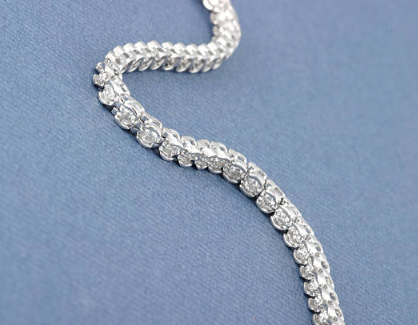Maybe you have a diamond bracelet but aren’t sure if its gemstones are genuine. Or, you may be about to buy one and want to make sure you’re not buying a fake gemstone for the price of a real diamond. Regardless, here are some tips to help you tell if a diamond bracelet is made with real or fake diamonds.
Breath Test
One way to test if a gemstone is a real diamond is to breathe into the gem and watch how quickly the fog created by your breath on the gemstone’s surface disappears. If the diamond is real, the moisture will disappear almost immediately.

If the fog lasts for a few seconds and does not disappear immediately, then the stone is most likely not a real diamond.
The problem with this test is that if you are dealing with a material with similar thermal properties to diamond, it is unreliable: in this case, the fog may disappear quickly, but this does not serve as conclusive evidence that the diamond is real.
A Real Diamond Should Not Have Scratches
A real diamond may chip, but since it is very durable, there should be no scratches.
If you notice that the gemstones in your bracelet have accumulated scratches over time, it is unlikely that these gemstones are made of real diamonds.
You most likely have imitations made from softer materials like glass or cubic zirconia, which can be easily scratched.
The downside of this test is that if the bracelet is new, it is unlikely to have scratches on its gemstones.
All of this leads us to the most reliable way to detect fake diamonds: using a diamond tester.
Diamond Tester
A diamond tester is a device that detects whether a gemstone is a diamond by using heat or electrical impulses to test its physical properties.
Devices that test conductivity are more accurate – those that use heat can mistake moissanite (a mineral commonly used as a diamond simulant) for diamond because both materials conduct heat in much the same way.
You can pay to test the diamonds in your bracelet at most jewelry stores.
Almost all professional jewelers are equipped with diamond testers. Just don’t forget to ask if the tester can detect moissanite.
Methods of Detecting Fake Diamonds Are Unreliable
There are some methods for testing fake diamonds that are widely considered to be accurate, but in fact there are no conclusions.
It has been argued that if a stone can scratch glass, then that stone is a diamond. While diamond can scratch glass, so can other materials that are harder than it.

For example, white sapphire and moissanite, two materials commonly used to make fake diamonds, are very hard and can scratch glass.
Another way to be uncertain is to look through the diamond to see if something on the other end is clearly visible (e.g., if the printed text is readable).
Because diamonds distort light, you shouldn’t be able to see clearly through the diamond, or the logic of the test is like this.
Although this is true in many cases, a diamond with a shallow cut, such as an emerald cut, does not distort light as much as a round diamond.
Even though they are real diamonds, you may be able to see through these light gemstones very well.
